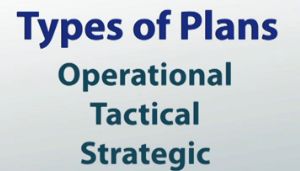Types of Planning: Strategic, Tactical, Operational & Contingency Planning - Quiz
Choose your answer and write the correct one down. Then click HERE for the answers to this quiz.
NOTE: The transcript from the video is listed below the quiz for your reference.
1. This type of plan is concerned with responsibility and functionality of lower level departments.
- operational
- strategic
- contingency
- tactical
2. This type of plan can be single-use or ongoing.
- strategic
- tactical
- contingency
- operational
3. This type of plan is designed with the entire organization in mind and begins with an organization's mission.
- operational
- tactical
- strategic
-
contingency
4. This type of plan is used by a manager to complete daily responsibilities.
- operational
- tactical
- strategic
- contingency
5. The four types of plans a manager will use include
- forecast, operational, tactical, contingency
- operational, tactical, strategic, contingency
- operational, strategic, calculated, contingency
- single use, tactical, long-term, contingency
This lesson will explain the four types of planning used by managers, including strategic, tactical, operational and contingency planning. Terms, such as single-use plans, continuing plans, policy, procedure and rule, will also be defined.
Planning to Plan
Have you ever heard the saying 'Those who fail to plan, plan to fail'? While I can't speak to all facets of life, this is certainly true in business. Managers find themselves planning for all sorts of things. So much so, that planning is one of the four major functions of management. In doing so, a manager can be certain that he or she is working toward some organization goal.
There are three main types of plans that a manager will use in his or her pursuit of company goals, which include operational, tactical and strategic. If you think about these three types of plans as stepping stones, you can see how their relationship to one another aids in the achievement of organizational goals. Operational plans are necessary to attain tactical plans and tactical plans lead to the achievement of strategic plans. Then, in true planning fashion, there are also plans to backup plans that fail. These are known as contingency plans. To better understand how each type of plan is used by managers, let's take a look at an example from Nino's Pizzeria and how Tommy, Martha and Frank carry out their planning responsibilities.
 |
Strategic Plans
To best understand the relationship between the different types of plans, let's start at the top. Strategic plans are designed with the entire organization in mind and begin with an organization's mission. Top-level managers, such as CEOs or presidents, will design and execute strategic plans to paint a picture of the desired future and long-term goals of the organization. Essentially, strategic plans look ahead to where the organization wants to be in three, five, even ten years. Strategic plans, provided by top-level managers, serve as the framework for lower-level planning.
Tommy is a top-level manager for Nino's Pizzeria. As a top-level manager, Tommy must use strategic planning to ensure the long-term goals of the organization are reached. For Tommy, that means developing long-term strategies for achieving growth, improving productivity and profitability, boosting return on investments, improving customer service and finding ways to give back to the community in which it operates.
 |
Tactical Plans
Now that you have a general idea for how organizational planning evolves, let's look at the next level of planning, known as tactical planning. Tactical plans support strategic plans by translating them into specific plans relevant to a distinct area of the organization. Tactical plans are concerned with the responsibility and functionality of lower-level departments to fulfill their parts of the strategic plan.
For example, when Martha, the middle-level manager at Nino's, learns about Tommy's strategic plan for increasing productivity, Martha immediately begins to think about possible tactical plans to ensure that happens. Tactical planning for Martha might include things like testing a new process in making pizzas that has been proven to shorten the amount of time it takes for prepping the pizza to be cooked or perhaps looking into purchasing a better oven that can speed up the amount of time it takes to cook a pizza or even considering ways to better map out delivery routes and drivers. As a tactical planner, Martha needs to create a set of calculated actions that take a shorter amount of time and are narrower in scope than the strategic plan is but still help to bring the organization closer to the long-term goal.
 |
Operational Plans
Operational plans sit at the bottom of the totem pole; they are the plans that are made by frontline, or low-level, managers. All operational plans are focused on the specific procedures and processes that occur within the lowest levels of the organization. Managers must plan the routine tasks of the department using a high level of detail.
Frank, the frontline manager at Nino's Pizzeria, is responsible for operational planning. Operational planning activities for Frank would include things like scheduling employees each week; assessing, ordering and stocking inventory; creating a monthly budget; developing a promotional advertisement for the quarter to increase the sales of a certain product (such as the Hawaiian pizza) or outlining an employee's performance goals for the year.
Operational plans can be either single-use or ongoing plans. Single-use plans are those plans that are intended to be used only once. They include activities that would not be repeated and often have an expiration. Creating a monthly budget and developing a promotional advertisement for the quarter to increase the sales of a certain product are examples of how Frank would utilize single-use planning.
 |
Ongoing plans are those plans that are built to withstand the test of time. They are created with the intent to be used several times and undergo changes when necessary. Outlining an employee's performance goals for the year would be considered an ongoing plan that Frank must develop, assess and update, if necessary. Ongoing plans are typically a policy, procedure or rule. Policies are general statements, or guidelines, that aid a manager in understanding routine responsibilities of his or her role as a manager. Examples of policies include things such as hiring, training, outlining and assessing performance appraisals and disciplining and terminating subordinates. A procedure details the step-by-step process of carrying out a certain task, such as assessing, ordering and stocking inventory. A rule provides managers and employees with specific and explicit guidelines of behavior that is what they should and should not do as a member of the organization.
Contingency Plans
Even the best plans can fail, especially in today's fast-paced, chaotic business environment, and as such, it is important for managers at all levels to engage in contingency planning. Contingency plans allow a manager to be flexible and change-savvy by providing an alternative course of action, which can be implemented if and when an original plan fails to produce the anticipated result. Having a contingency plan might seem like extra work, but much like a reserve parachute when skydiving, it's better to have it and not need it than to need it and not have it.
 |
Lesson Summary
Let's review. Planning is one of the four functions of management that allows a manager to develop and implement strategic action steps aimed at reaching an organizational goal. There are three major types of planning, which include operational, tactical and strategic planning. A fourth type of planning, known as contingency planning, is an alternative course of action, which can be implemented if and when an original plan fails to produce the anticipated result. It helps to think about operational, tactical and strategic planning as a set of stepping stones, where each one plays a part in working toward a greater organizational goal. Operational plans are necessary to attain tactical plans, and tactical plans lead to the achievement of strategic plans.
Achieving organizational goals starts with top managers who create strategic plans that paint a picture of the desired future and long-term goals of the organization, such as increasing productivity or profitability. These strategic plans serve as a framework for lower-level planning. Tactical plans support strategic plans by translating them into specific plans relevant to a distinct area of the organization.
Tactical plans are concerned with the responsibility and functionality of lower-level departments to fulfill their parts of the strategic plan, such as testing out a new product that can shorten production time.
Operational plans are made by frontline, or lower-level, managers and are focused on the specific procedures and processes that occur within the lowest levels, almost the individual level, of the organization. Examples of operational plans include things like scheduling employees each week; assessing, ordering and stocking inventory or creating a monthly budget.
Operational plans can be either single-use or ongoing plans. Single-use plans are those plans that are intended to be used only once. They include activities that would not be repeated and often have an expiration, such as a monthly budget. Ongoing plans are those plans that are built to withstand the test of time. They are created with the intent to be used several times and undergo changes when necessary. Outlining an employee's performance goals for the year would be considered an ongoing plan. Ongoing plans are typically a policy, procedure or rule.